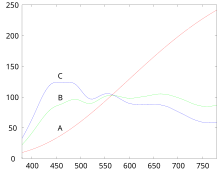Standard light

The spectral curves of some standard illuminants standardized by the CIE
The standardized spectral radiation distribution curves of characteristic emitters are called standard light .
Radiation distributions that are almost identical to the black body are assigned to color temperatures . These correspond to the radiation emitted by the black body at the corresponding temperature.
The criteria for standard light are defined in the ISO standard ISO 3664
Differentiation areas
Some selected standard illuminants with details of the color temperature and the color value proportions:
- Standard illuminant A : relative radiation distribution of the Planckian (black) radiator with 2856 Kelvin
-
Standard illuminant D65 : Radiation distribution with a color temperature of 6504 Kelvin (corresponds roughly to a gray overcast sky). D50 (preferred in the printing industry), D55 and D75 are also standardized; the color temperature is added in 100 K , e.g. B. D50 = daylight from 5000 K.
The beginning with "D" standard illuminants corresponding to daylight (s: daylight ) and include the natural UV components of sunlight , while not visible to humans, but when working with fluorescent are important surfaces (e.g. with certain types of paper ). - Standard light types F1 ... F12 : department store light , for fluorescent lamps with different UV components.
| Standard illuminant | x (red) | y (green) | z (blue) | Color temperature | annotation |
|---|---|---|---|---|---|
| A. | 0.448 | 0.407 | 0.145 | 2856 K | conventional incandescent lamp |
| C. | 0.309 | 0.319 | 0.372 | 6774 K | Daylight , today D65 instead |
| E. | 0.333 | 0.333 | 0.333 | 5454 K | No real light source. energetic equivalence point |
| B. | 0.349 | 0.354 | 0.298 | 4874 K |
today no longer common light bulb with an upstream copper sulphate - cell , to simulate daylight. |
See also
Web links
- Konica Minolta Sensing: Types of Light and Light Sources